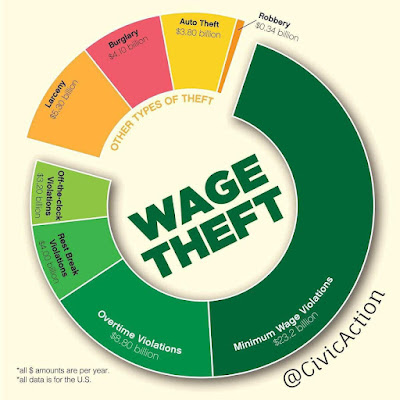could be a solution to the labor shortage
Jeff Arview had been kicking around in different jobs. An Army veteran who served in Iraq, after he was discharged he suffered from post-traumatic stress disorder and fell into addiction, which led to fighting and theft — then arrests and jail time. Moving on and getting a job was a challenge.
“Even though I was a veteran, because of that criminal history, I was unable to gain employment, which made it really tough,” Arview said. At times, he fell into homelessness.
Arview, 39, is far from alone. The unemployment rate among formerly incarcerated people was 27%, according to a 2018 analysis by the Prison Policy Initiative. That compares with the current overall U.S. unemployment rate of 4.8% in September. A criminal background has carried a stigma for some employers, and in some states there are steep legal hurdles to clearing one's record.
When looking for jobs, Arview came across a recruitment video from staffing company Kelly Services targeting veterans. Enough time had passed since his last arrest that he wasn’t legally required to disclose it when applying — although he eventually did. He was hired as a contractor, then as a full-time talent adviser two and a half years ago.
Second-chance initiatives 'tap into talent' amid a labor crunch
Last month, Kelly Services introduced a recruiting program specifically designed for people with non-violent criminal records. It’s one of an increasing number of companies trying to de-stigmatize so-called “second chance” workers with dual-pronged philanthropic and self-interested goals — help people get back on their feet, and find workers in a tight job market.
Kelly Services CEO Peter Quigley said the latter is a challenge right now.
“The fact is that there are a lot of open jobs, but there are not a lot of jobs open that people want,” he told Yahoo Finance Live in an interview. He said employers have to address employees’ shifting priorities, including offering them paths to career advancement and an inclusive and diverse workplace.
Kelly Services’s program targeting criminal offenders, called Kelly 33, kicked off after an initial partnership with Toyota, where 645 workers accepted jobs at the automaker’s Georgetown, Kentucky plant.
“Toyota took a second-chance initiative and was able to increase its talent pool by 20%, increase its diversity by almost 10%, and improve its retention by 70%. These second-chance workers are thankful, they’re reliable and they’re loyal,” Quigley said.
Kelly Services and Toyota aren’t alone. A group of companies in April started the Second Chance Business Coalition, led by co-chairs Jamie Dimon, chairman and CEO of JPMorgan Chase, and Craig Arnold, chairman and CEO of Eaton.
JPMorgan hired 2,100 people with criminal backgrounds in 2020, about 10% of new hires. That was thanks in part to partnerships with community groups in Chicago and Columbus, who trained potential employees and educated them on banking regulations.
“This is making sure we tap into talent that maybe wouldn’t come our way,” said Michelle Kuranty, executive director — global head of talent acquisition sourcing at JPMorgan. “Good talent is always a challenge.”
JPMorgan and the coalition are also pushing for policy changes, including “banning the box” — not including a box on job applications for candidates to check if they have a criminal record — and “clean slate” policies to clear or seal criminal records.
Employers are 'a little more open minded' about criminal records
Americans who have been incarcerated or have a conviction on their record are “ready to work and deserve a second chance — an opportunity to fill the millions of job openings across the country,” wrote Dimon in an August op-ed. “Yet our criminal justice system continues to block them from doing so.”
Economists estimate that U.S. employers hired 500,000 workers in September, up from 235,000 in August. That contrasts with the nearly 11 million jobs that were open in July. Recent jobs data has been lagging forecasts, for reasons ranging from difficult-to-secure child care to geography and skills mismatches.
“When you’re in the legal system, there’s a lot of pressure, it’s not just financial pressure. It’s hard to find somebody that offers you any kind of hope,” said David Shaffer, who was arrested for his third DWI in 2009, a felony in Texas. “Once you get in trouble, the world is full of people telling you what you can’t do.”
By the following year, he was searching for jobs, and got a call from Kelly Services, to whom he disclosed his criminal issues. Eleven years later, he’s still working there, as a senior operations manager.
His colleague, Jeff Arview, said work culture is continuing to change. “Employers are being a little more open minded to it, given the workforce that is needed right now, and I think that is awesome, because they’ll actually give people a chance.”
Correction: JPMorgan partnered with community groups in Columbus. The city was misstated in an earlier version of this article.
This post has been updated with the September jobs numbers.
Julie Hyman is the co-anchor of Yahoo Finance Live, weekdays 9am-11am ET. Follow her on Twitter @juleshyman, and read her other stories.




:max_bytes(150000):strip_icc():format(webp)/BlockReward-5c1bf7cf46e0fb0001dad7cc.png) The rate that bitcoin are produced cuts in half about every four years. Investopedia
The rate that bitcoin are produced cuts in half about every four years. Investopedia












